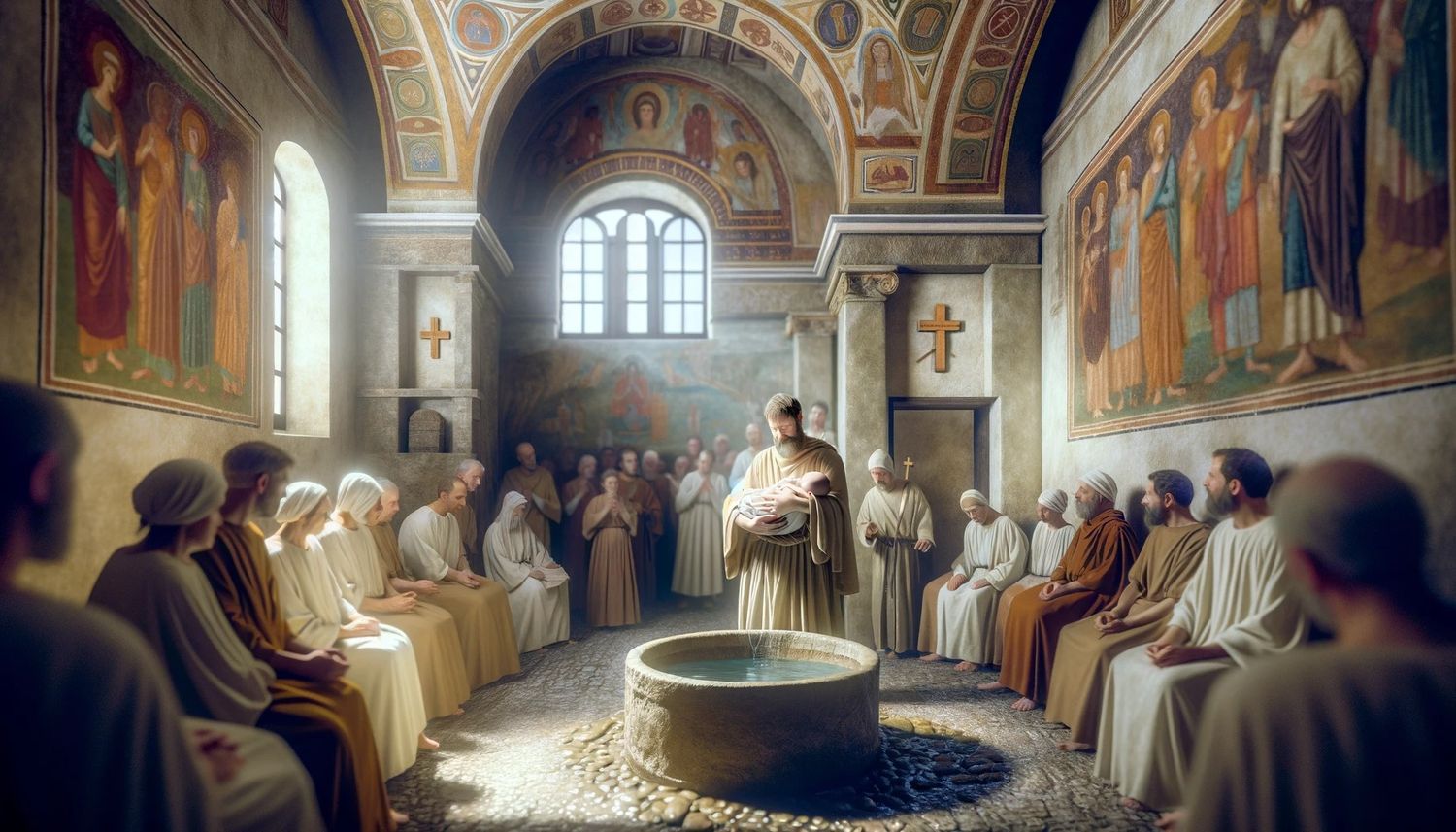Home>Theology and Spirituality>How Did Baptism Originate


Theology and Spirituality
How Did Baptism Originate
Published: February 26, 2024
Peter Smith, Editorial Director at Christian.net, combines deep insights into faith, politics, and culture to lead content creation that resonates widely. Awarded for his contributions to religious discourse, he previously headed a major organization for religious communicators, enhancing dialogue on faith's societal impacts.
Discover the origins of baptism and its significance in theology and spirituality. Explore the historical and religious roots of this sacred ritual.
(Many of the links in this article redirect to a specific reviewed product. Your purchase of these products through affiliate links helps to generate commission for Christian.net, at no extra cost. Learn more)
Table of Contents
The Origins of Baptism in Ancient Rituals
Baptism, a sacred rite in Christianity, has its roots in ancient rituals that predate the emergence of the Christian faith. The practice of ritual purification through water is a common thread that connects various ancient cultures and religions. In ancient Egypt, the act of bathing in the Nile River was believed to cleanse the individual of impurities and symbolize a spiritual rebirth. Similarly, in Hinduism, the ritual of immersion in the sacred waters of the Ganges River is seen as a means of spiritual purification and renewal. These ancient practices demonstrate the universal human inclination towards using water as a symbol of spiritual cleansing and rebirth.
The concept of baptism also finds resonance in the Jewish tradition, where ritual immersion, known as mikvah, is an integral part of the purification process. In Judaism, immersion in a mikvah is associated with spiritual renewal and the removal of impurities, preparing the individual for sacred activities or transitions. This ancient Jewish practice laid the foundation for the Christian ritual of baptism, as it provided a framework for understanding the symbolic significance of immersion in water as a transformative and purifying act.
Furthermore, in the Greco-Roman world, various mystery cults and religious traditions incorporated the use of water in their initiation rites. The followers of Mithraism, for example, participated in a ritual bath as part of their initiation into the mysteries of the god Mithras. This act of immersion was believed to cleanse the initiates of their past sins and prepare them for spiritual enlightenment. Similarly, the cult of Isis included rituals of purification and initiation that involved immersion in water, symbolizing a spiritual rebirth and the attainment of divine favor.
The diverse ancient rituals involving water as a purifying agent laid the groundwork for the development of baptism within the early Christian community. As Christianity spread and encountered different cultural and religious practices, the symbolic significance of water as a means of spiritual purification and rebirth became intertwined with the Christian understanding of salvation and initiation into the faith. This historical context underscores the rich tapestry of influences that contributed to the origins of baptism as a central sacrament in Christian tradition.
Read more: How Did Baptism Begin?
The Role of Baptism in Early Christian Communities
-
Initiation into the Christian Community: In the early Christian communities, baptism played a pivotal role as the primary rite of initiation into the faith. Through the act of baptism, individuals publicly declared their commitment to the Christian beliefs and community. This symbolic act marked the beginning of their journey as followers of Christ and members of the Christian community.
-
Cleansing and Forgiveness of Sins: Baptism was also understood as a means of spiritual cleansing and the forgiveness of sins. Early Christians believed that through the waters of baptism, individuals were cleansed of their past transgressions and welcomed into a new life of grace and redemption. The act of immersion in water symbolized the washing away of sin and the emergence of a renewed, spiritually purified individual.
-
Union with Christ's Death and Resurrection: Early Christian theology emphasized the profound spiritual significance of baptism in relation to the death and resurrection of Jesus Christ. Baptism was seen as a participation in Christ's death, burial, and resurrection, symbolizing the believer's union with Christ and the transformative power of his redemptive work. This union with Christ's salvific acts was considered essential for the believer's spiritual rebirth and new life in the Christian faith.
-
Reception of the Holy Spirit: In early Christian understanding, baptism was closely associated with the reception of the Holy Spirit. The act of baptism was believed to be accompanied by the outpouring of the Holy Spirit upon the individual, empowering them for their Christian journey and equipping them for a life of faith and discipleship. This reception of the Holy Spirit was seen as a vital aspect of the believer's new identity and role within the Christian community.
-
Incorporation into the Body of Christ: Baptism was also viewed as the means through which individuals were incorporated into the mystical body of Christ, which is the Church. Through baptism, believers were united with one another and with Christ, forming a spiritual bond that transcended earthly boundaries and distinctions. This communal aspect of baptism underscored the interconnectedness of the early Christian communities and the shared identity of believers as members of the body of Christ.
-
Preparation for Martyrdom and Perseverance: In the context of persecution and hardship faced by early Christians, baptism served as a preparation for potential martyrdom and the endurance of trials. Believers understood baptism as a commitment to follow Christ, even in the face of suffering and persecution. The act of baptism symbolized the believer's willingness to embrace the challenges of discipleship and remain steadfast in their faith, regardless of the obstacles they might encounter.
-
Continuity with Jewish Purification Rites: For early Jewish converts to Christianity, baptism also held significance as a continuation of the purification rituals found in their Jewish heritage. The act of immersion in water resonated with the Jewish tradition of ritual purification, providing a familiar framework for understanding the spiritual symbolism of baptism within the context of their new Christian faith.
The role of baptism in early Christian communities was multifaceted, encompassing themes of initiation, purification, spiritual transformation, communal identity, and perseverance in the face of adversity. This foundational sacrament served as a visible sign of the believer's commitment to Christ and their participation in the life of the Christian community.
The Evolution of Baptismal Practices in the Early Church
-
Emergence of Varied Practices: In the early centuries of Christianity, diverse baptismal practices began to emerge across different regions and communities within the Church. While the essential act of immersion in water remained central to the ritual, variations in the liturgical elements, the theological emphasis, and the accompanying prayers and blessings started to develop. These regional differences reflected the cultural and theological diversity within the early Christian world and contributed to the rich tapestry of baptismal practices.
-
Shift from Adult to Infant Baptism: Initially, adult baptism was the predominant form of the sacrament in the early Church, aligning with the New Testament accounts of adult conversions and baptisms. However, as the Church expanded and the influence of infant inclusion in the covenant community grew, the practice of infant baptism began to gain traction. The theological understanding of baptism as a means of cleansing from original sin and the incorporation of infants into the faith community led to the gradual acceptance of infant baptism as a normative practice within the Church.
-
Development of Baptismal Rites and Liturgies: The early Church witnessed the development of formalized baptismal rites and liturgies, particularly in the context of catechumenal preparation. Catechumens, individuals undergoing instruction in the Christian faith, participated in a period of preparation leading up to their baptism. This process, known as the catechumenate, involved teachings, prayers, exorcisms, and various rituals designed to prepare the candidates for their baptismal initiation. The evolution of these preparatory rites contributed to the establishment of a structured and ceremonial approach to baptism within the early Church.
-
Theological Reflection and Formulation: As the Church grappled with theological questions surrounding baptism, particularly regarding its relationship to sin, grace, and the nature of the sacrament, theologians and church leaders engaged in extensive reflection and formulation of baptismal theology. The writings of early Christian theologians, such as Augustine of Hippo and Cyprian of Carthage, provided significant insights into the evolving understanding of baptism as a sacramental act, shedding light on its spiritual significance and the theological implications of the rite.
-
Integration of Symbolic Elements: Over time, baptismal practices incorporated a range of symbolic elements and gestures, each carrying profound spiritual significance. The use of consecrated water, anointing with oil, the laying on of hands, the renunciation of evil, and the profession of faith became integral components of the baptismal liturgy. These symbolic actions served to deepen the theological meaning of baptism and underscored the believer's participation in the death and resurrection of Christ.
-
Ecclesiastical Regulations and Uniformity: As the Church sought to maintain doctrinal unity and consistency in its sacramental practices, ecclesiastical regulations and canons were established to govern the administration of baptism. These regulations addressed issues such as the qualifications of the baptizer, the proper formula for baptismal invocation, and the validity of baptisms performed outside the established norms. The pursuit of uniformity in baptismal practices reflected the Church's commitment to upholding the integrity of the sacrament across its diverse communities.
The evolution of baptismal practices in the early Church reflects the dynamic interplay of theological, cultural, and ecclesiastical factors that shaped the development of this central sacrament. The diverse expressions of baptism within the early Christian tradition attest to the richness and complexity of its historical evolution.
The Symbolism and Significance of Baptism in Christian Theology
-
Cleansing and Rebirth: Baptism is rich in symbolism, representing the cleansing of the individual from sin and the experience of spiritual rebirth. The act of immersion in water signifies the washing away of past transgressions and the emergence of a new life in Christ. This cleansing and renewal are central to the Christian understanding of baptism, reflecting the believer's desire for forgiveness and a fresh start in their spiritual journey.
-
Identification with Christ's Death and Resurrection: In Christian theology, baptism is deeply connected to the death and resurrection of Jesus Christ. Through baptism, individuals symbolically participate in Christ's death, burial, and resurrection, signifying their union with him in his redemptive work. This identification with Christ's salvific acts underscores the believer's acceptance of the transformative power of the gospel and their commitment to a life shaped by the reality of Christ's victory over sin and death.
-
Incorporation into the Body of Christ: Baptism also holds profound significance in terms of the believer's incorporation into the mystical body of Christ, which is the Church. Through baptism, individuals are united with Christ and with fellow believers, forming a spiritual bond that transcends individual identity and earthly distinctions. This communal aspect of baptism emphasizes the interconnectedness of the Christian community and the shared identity of believers as members of the body of Christ.
-
Reception of the Holy Spirit: Christian theology views baptism as the moment of the believer's reception of the Holy Spirit. The act of baptism is believed to be accompanied by the outpouring of the Holy Spirit, empowering the individual for their Christian journey and equipping them for a life of faith and discipleship. This reception of the Holy Spirit is seen as a transformative experience, marking the believer's new identity and role within the Christian community.
-
Seal of God's Covenant: Baptism is often understood as the seal of God's covenant with the believer. Just as circumcision was a sign of the covenant in the Old Testament, baptism serves as a visible sign of the believer's inclusion in the new covenant established through the life, death, and resurrection of Jesus Christ. This symbolic sealing signifies the believer's commitment to God and their participation in the promises of the gospel.
-
Initiation into Christian Life: Beyond its symbolic dimensions, baptism is the initiation into the Christian life and the visible entry into the community of faith. It marks the public declaration of one's commitment to Christ and the acknowledgment of the Christian community as the context for spiritual growth, fellowship, and mutual support. Baptism serves as the threshold through which individuals enter into a life of discipleship and service within the body of Christ.
-
Anticipation of Resurrection: Christian theology also sees baptism as a foreshadowing of the believer's future resurrection. Just as Christ was raised from the dead, believers anticipate their own resurrection to eternal life. The act of immersion in water and emergence from it symbolizes this hope of future resurrection, affirming the believer's confidence in the promise of new life in Christ beyond the limitations of earthly existence.
The symbolism and significance of baptism in Christian theology encompass a rich tapestry of spiritual meanings, reflecting the believer's relationship with God, Christ, the Church, and the hope of eternal life. This sacrament serves as a visible and profound expression of the believer's faith and their participation in the redemptive work of God.
The Spread of Baptism as a Sacrament in Christian Tradition
-
Early Missions and Expansion: As Christianity spread beyond its Jewish origins, the practice of baptism as a sacrament became an integral part of the Church's missionary efforts. The early Christian missionaries carried the message of the gospel and the rite of baptism to diverse cultural and geographical contexts, where it took root and became a central feature of Christian initiation. The spread of baptism as a sacrament mirrored the expansion of the Christian faith into new regions and communities, shaping the religious landscape of the ancient world.
-
Integration with Local Customs and Beliefs: In the process of spreading across different regions, the practice of baptism encountered a variety of local customs, beliefs, and religious traditions. The incorporation of baptism into these diverse cultural contexts led to the adaptation of certain elements of the ritual to resonate with the symbolism and practices familiar to the local populations. This integration facilitated the assimilation of baptism into the religious fabric of the communities where Christianity took hold, contributing to its widespread acceptance as a sacramental rite.
-
Establishment of Baptismal Norms and Practices: As the Church expanded and established itself in various regions, ecclesiastical authorities sought to standardize the administration of baptism and regulate its theological and liturgical aspects. This process involved the formulation of baptismal norms, the delineation of proper procedures for baptism, and the clarification of theological understandings related to the sacrament. The establishment of these norms contributed to the uniformity of baptismal practices within the broader Christian tradition, ensuring consistency across different communities.
-
Incorporation into Liturgical Life: Baptism became an integral part of the liturgical life of the Church, finding its place within the annual cycle of feasts and celebrations. The liturgical calendar of the Church included specific days and seasons dedicated to the administration of baptism, such as the Easter Vigil, when catechumens were traditionally baptized. This integration of baptism into the Church's liturgical rhythm underscored its significance as a central sacrament and highlighted its connection to the foundational events of Christian faith, particularly the death and resurrection of Jesus Christ.
-
Theological Reflection and Artistic Depictions: The spread of baptism as a sacrament also prompted theological reflection on its meaning and significance within the Christian tradition. The writings of theologians and church leaders, as well as the development of liturgical texts and prayers related to baptism, contributed to a deeper understanding of its theological implications. Additionally, artistic depictions of baptism in early Christian art and iconography served to visually communicate the spiritual truths associated with the sacrament, further reinforcing its importance within the Christian imagination.
-
Continuity and Adaptation: Over time, the spread of baptism as a sacrament demonstrated a balance between continuity and adaptation. While maintaining its essential theological and ritual elements, baptism adapted to the cultural, linguistic, and contextual diversity of the Christian world. This adaptability allowed baptism to resonate with people from various backgrounds, fostering a sense of unity and shared identity within the diverse tapestry of the Church.
The spread of baptism as a sacrament in Christian tradition reflects the dynamic interplay between the Church's missionary endeavors, cultural integration, ecclesiastical regulation, liturgical incorporation, theological reflection, and adaptability to diverse contexts. This widespread acceptance and practice of baptism as a sacrament underscore its enduring significance as a foundational rite within the Christian faith.















